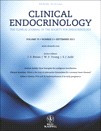Soucek O, Lebl J, Snajderova M, Kolouskova S, Rocek M, Hlavka Z, Cinek O, Rittweger J, Sumnik Z. Clin Endocrinol (Oxf). 2011 Apr;74(4):445–52. doi: 10.1111/j.1365-2265.2010.03955.x. IF: 3.201

Abstract:
OBJECTIVE: An increased rate of fractures has been reported in patients with Turner syndrome (TS). We aimed to assess bone geometry and volumetric bone mineral density (vBMD) at the radius in girls with TS and to evaluate the relationships between bone parameters and fracture history. METHODS AND DESIGN: Sixty-seven girls with TS aged 6–19 years treated currently or in the past with growth hormone (GH) and/or oestrogens were examined using peripheral quantitative computed tomography. Results were compared to reference data. RESULTS: Cortical area and cortical thickness were low in all age groups (all P < 0.001). Height-adjusted total bone area at the diaphysis was increased in prepubertal and postpubertal girls (mean Z-score 1.0, P < 0.05 for both) and normal in the pubertal group (mean Z-score 0.1). Cortical vBMD was decreased (mean age-specific Z-scores –2.0, –1.6 and –1.0 for prepubertal, pubertaland postpubertal groups, respectively, P < 0.01 for all groups). Height-, age- and cortical thickness-adjusted cortical vBMD was positively correlated to the duration of GH therapy (P = 0.012) and to oestrogen administration (P = 0.047). Girls with a history of fractures had lower total vBMD at the metaphysis compared to nonfractured TS girls (mean Z-scores –1.7 vs –0.9, P = 0.04). CONCLUSIONS: There is a cortical bone deficit in girls with TS characterized by low cortical area, thin cortex and probably decreased cortical vBMD. Early commencement of GH therapy, as well as oestrogen replacement, is associated with higher cortical vBMD. Further studies should investigate the potential causality of this relation.
-mk-